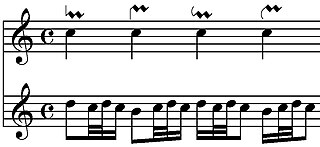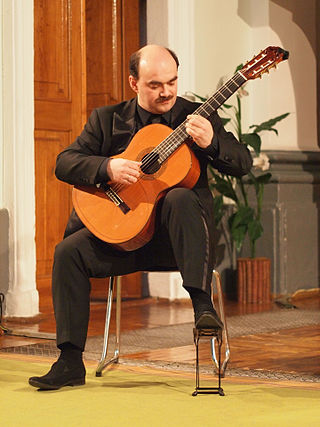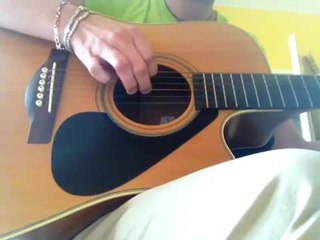In music performance and notation, legato indicates that musical notes are played or sung smoothly and connected. That is, the player makes a transition from note to note with no intervening silence. Legato technique is required for slurred performance, but unlike slurring, legato does not forbid re-articulation.
In music, tremolo, or tremolando, is a trembling effect. There are two types of tremolo: either a rapid repetition of a note, or a variation in volume.
The trill is a musical ornament consisting of a rapid alternation between two adjacent notes, usually a semitone or tone apart, which can be identified with the context of the trill. It is sometimes referred to by the German Triller, the Italian trillo, the French trille or the Spanish trino. A cadential trill is a trill associated with each cadence. A trill provides rhythmic interest, melodic interest, and—through dissonance—harmonic interest. Sometimes it is expected that the trill will end with a turn, or some other variation. Such variations are often marked with a few appoggiaturas following the note bearing the trill indication.

Joseph Satriani is an American rock guitarist, composer, and songwriter. Early in his career he worked as a guitar instructor, with many of his former students achieving fame, including Steve Vai, Larry LaLonde, Rick Hunolt, Kirk Hammett, Andy Timmons, Charlie Hunter, Kevin Cadogan, and Alex Skolnick. Satriani went on to have a successful solo music career, starting in the late 1980s. He is a 15-time Grammy Award nominee and has sold over ten million albums, making him the bestselling instrumental rock guitarist of all time.
Sweep picking is a guitar playing technique. When sweep picking, the guitarist plays single notes on consecutive strings with a 'sweeping' motion of the pick, while using the fretting hand to produce a specific series of notes that are fast and fluid in sound. Both hands essentially perform an integral motion in unison to achieve the desired effect.

Tapping is a playing technique that can be used on any stringed instrument, but which is most commonly used on guitar. The technique involves a string being fretted and set into vibration as part of a single motion. This is in contrast to standard techniques that involve fretting with one hand and picking with the other. Tapping is the primary technique intended for instruments such as the Chapman Stick.
A hammer-on is a playing technique performed on a stringed instrument by sharply bringing a fretting-hand finger down on to the fingerboard behind a fret, causing a note to sound. This technique is the opposite of the pull-off.
A variety of musical terms are encountered in printed scores, music reviews, and program notes. Most of the terms are Italian, in accordance with the Italian origins of many European musical conventions. Sometimes, the special musical meanings of these phrases differ from the original or current Italian meanings. Most of the other terms are taken from French and German, indicated by Fr. and Ger., respectively.

A drum roll is a technique used by percussionists to produce a sustained sound for the duration of a written note.
All drum figures are based upon three fundamental beats, technically called roll, single stroke, and flam...Sustentation is accomplished upon wind instruments by blowing into the instrument; it is accomplished upon the violin and the allied instruments by drawing the bow across the string; it is accomplished upon the drum and allied percussion instruments by the roll.
THE SNARE DRUM ROLL.
The roll consists of an even reiteration of beats sufficiently rapid to prohibit rhythmic analysis. To produce an impression of sustentation, these beats must be absolutely even both in power and in sequence. Uneven beats in a roll destroy the impression of sustentation. Evenness is then the primary quality to strive for in roll; speed is the secondary quality to strive for.
There are two possible ways of producing an absolutely even sequence: (1) hand alternation of single stroke and (2) hand alternation of double strokes...The snare drum roll is produced by hand alternation of double strokes.
The "open roll" is produced by [initially] slow hand alternation. Two strokes in each hand alternately are produced by wrist movement and each beat should follow its predecessor in clock-like precision.

In music, a mordent is an ornament indicating that the note is to be played with a single rapid alternation with the note above or below. Like trills, they can be chromatically modified by a small flat, sharp or natural accidental. The term entered English musical terminology at the beginning of the 19th century, from the German Mordent and its Italian etymon, mordente, both used in the 18th century to describe this musical figure. The word ultimately is derived from the Latin mordere.

Not of This Earth is the debut studio album by guitarist Joe Satriani, released on December 18, 1986, through Relativity Records.
Alternate picking is a guitar playing technique that employs alternating downward and upward strokes in a continuous fashion. If the technique is performed at high speed on a single string or course voicing the same note, it may be referred to as "tremolo picking" or "double picking".

Shred guitar or shredding is a virtuoso style of playing the electric guitar, based on various advanced and complex playing techniques, particularly rapid passages and advanced performance effects. Shred guitar includes fast alternate picking, sweep-picked arpeggios, diminished and harmonic scales, finger-tapping and whammy bar use. It is commonly used in heavy metal, where guitarists use the electric guitar with a guitar amplifier and a range of electronic effects such as distortion, which create a more sustained guitar tone and facilitate guitar feedback effects.
Pitch axis theory refers to a way of thinking about chord progressions and modes, that was heavily used and popularized by the guitarist Joe Satriani.
Economy picking is a guitar picking technique designed to maximize picking efficiency by combining alternate picking and sweep picking; it may also incorporate the use of legato in the middle of alternate picking passages as way to achieve higher speed with fewer pick strokes. Specifically:
Finger vibrato is vibrato produced on a string instrument by cyclic hand movements. Despite the name, normally the entire hand moves, and sometimes the entire upper arm. It can also refer to vibrato on some woodwind instruments, achieved by lowering one or more fingers over one of the uncovered holes in a trill-like manner. This flattens the note periodically creating the vibrato.

In classical guitar, the right hand is developed in such a way that it can sustain two, three, and four voice harmonies while also paying special attention to tone production. The index (i), middle (m), and ring (a) fingers are generally used to play the melody, while the thumb (p) accompanies in the bass register adding harmony and produces a comparable texture and effect to that of the piano. The classical guitar is a solo polyphonic instrument, and it is difficult to master.

Playing a string harmonic is a string instrument technique that uses the nodes of natural harmonics of a musical string to isolate overtones. Playing string harmonics produces high pitched tones, often compared in timbre to a whistle or flute. Overtones can be isolated "by lightly touching the string with the finger instead of pressing it down" against the fingerboard. For some instruments this is a fundamental technique, such as the Chinese guqin, where it is known as fan yin, and the Vietnamese đàn bầu.

Christian Münzner is a German guitarist who plays for the bands Obscura and Alkaloid. He is also known for playing for the technical death metal band Necrophagist from 2002 until 2006, appearing on their 2004 release Epitaph. As well as Necrophagist, Münzner played in Defeated Sanity from 1999 to 2002 and Obscura from 2008 to 2014, after which he left to co-found the extreme progressive metal supergroup Alkaloid. He rejoined Obscura in 2020.

Guitar picking is a group of hand and finger techniques a guitarist uses to set guitar strings in motion to produce audible notes. These techniques involve plucking, strumming, brushing, etc. Picking can be done with:









